(noon. – promoted by ek hornbeck)
Note: This being the anniversary of one of the best walks I’ve ever taken, I’ve decided to rework and re-post this essay , the second most popular piece I’ve ever written. Is is cross-posted at Firefly-Dreaming, La Vita Locavore and Progressive Blue.
Some things change. Some things, they stay the same. Time takes its toll but every now an then you can go back. On March 12, 2009 I went back to see what I could find from my childhood. I guess the reason I went was because another relic of that fair died that week when they pulled down the last tower of Shea Stadium. Many fond memories went down that day. One was from 1969 and another from 1986. Here let Louie Armstrong take you through a few stills from 1964.
There is a World’s Fair Stadium that is still standing. Did you know that Louis Armstrong Stadium, the main stadium of the U.S. Open until 1997 was the Singer Bowl during the World’s Fair? Singer as in sewing machines, which were a big deal in the 1960’s, so was the I.L.G.W.U.
There are still many fond memories to be found in the largest park in Queens. There were also a few questions about present day politics that were answered by looking back. May I suggest that you watch the video above for a look back and then come below the fold to see a few not old photos and a little of my history below.
You know if you ask most New Yorkers who attended The World’s Fair about the results afterward, you hear the same answer over and over “It’s a shame what they did to that park.” You don’t hear that from New Yorkers who live in that section of Queens, you hear it from New Yorkers who pass the park on the way to the airport “A crying shame.” The fact is that Flushing Meadows Corona Park is the second most visited park in New York City.
Those same New Yorkers who are so quick to tell you what a bad man Robert Moses was don’t know what was there before that bad man had his way with the park. People don’t know that Flushing Meadows Corona Park has risen like a phoenix from the ashes. People don’t know that the second largest park in New York City was an enormous ash pit before the beautification of that ash disposal site became the goal of a young Parks Commissioner. Nobody seems to remember F. Scott Fitzgerald’s description of Flushing Meadows in The Great Gatspy;
This is a valley of ashes – a fantastic farm where ashes grow like wheat into ridges and hills and grotesque gardens; where ashes take the form of houses and chimneys and rising smoke and, finally, with a transcendent effort, of ash-grey men who move dimly and already crumbling through the powdery air.
And the amazing part, the really amazing part was that that young Parks Commissioner was not satisfied with his first effort so he went back twenty-five years later as the most powerful man in the state. After the 1939 World’s Fair there was a landscaped park but the city left it unfinished. Outside of the 1939 New York City pavilion that served as the General Assembly chambers of the United Nations from 1946 to 1950, the park was neglected by the city government. Robert Moses took another crack at park improvement and in order to get it done right, the most powerful man in New York gave up all his other powers.
Surprisingly a man who, according to wiki, got his start under Alfred E. Smith, set in motion sweeping government consolidation that was later used as a model for Roosevelt’s New Deal is now remembered as a power hungry demigod but all that power was given up so his legacy would include vast parkland for the coming generations that would call Queens home. Interesting that the public works projects of today never get compared with the accomplishments of the man who got things done. I wonder what legacies the powerful men of today will leave behind, to hold up against the accomplishments of Robert Moses. I wonder if a powerful politician even exists anymore. Sure there was evidence of corporate ownership playing a role in politicians’ actions back then but there was also evidence of serving the people too.
Why is the man responsible for almost all of the infrastructure of both Long Island and New York City is still derided for cutting through neighborhoods and given credit from so many New Yorkers for urban blithe? Not so surprisingly is the fact that another doer came along, one of the very few New York politicians who were worth their salt to say something good about The Power Broker.
In a 2006 speech to the Regional Plan Association on downstate transportation needs, Eliot Spitzer, who would be overwhelmingly elected governor later that year, said a biography of Moses written today might be called At Least He Got It Built. “That’s what we need today. A real commitment to get things done.”
Setting aside one Pulitzer Prize winning biography that few have read and many can quote the negatives, the legacy that represents Robert Moses today is turning 1,255 acres of ash into this;
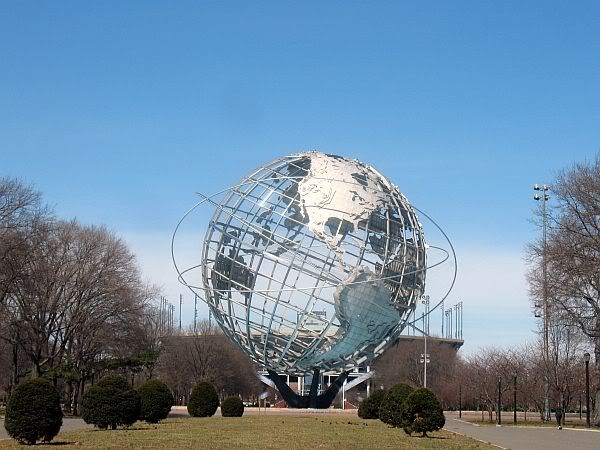
Here’s a little Unisphere trivia for you. Why are there three rings around the earth?
I remember a little bit of history. Perhaps my interest in history and science was born right there. So I went back to see what I could find from those days when the future seemed so bright. I never really gave much thought to the politics behind the birth of the New York World’s Fair until that day. My memories were all about learning and seeing amazing sights. But in going back to walk around seeking those memories in a park that seems so vibrant and alive to a city boy then and so calm and peaceful to a middle aged urbanite today, I looked at it again from the perspective of an adult. I hadn’t taken too many steps before asking “Why are there no more World’s Fairs for new generations of American children?”
For many people my age musical memory of the World’s Fair are the annoyingly addictive premiere of It’s a Small World, an exhibit that can still be seen in Disneyland. My musical memories were a little different. While I wasn’t one of the lucky kids that got to see them in Shea Stadium I remember many in the crowds with transistor radios playing the Beatles. So when I took my walk I had a Beatles soundtrack playing in my head and the taste of Belgian waffles in my mouth.
Getting off the subway last year and walking that lonely boardwalk from the Willits Point/Shea Stadium stop of the seven train I was amazed to see the flagpoles still there. It was like I’d gone back to the days when the flags of the world were flying from those poles and the boardwalk was so crowded that you inched your way through to wait on line and see the wonders of modern science and industry.
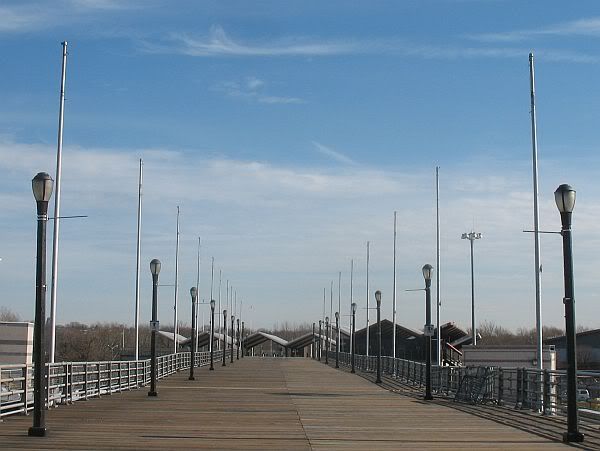
Looking back, Shea Stadium is no more. Having actually seen the Mets play at the Polo Grounds it seems a bit sad. Seeing Citibank’s name on the side of the new stadium very much seems like tragic symbol of changing times. Just the subway station reminds us of the powerful New York lawer Bill Shea, a man who could claim responsibility for the birth of the Mets.
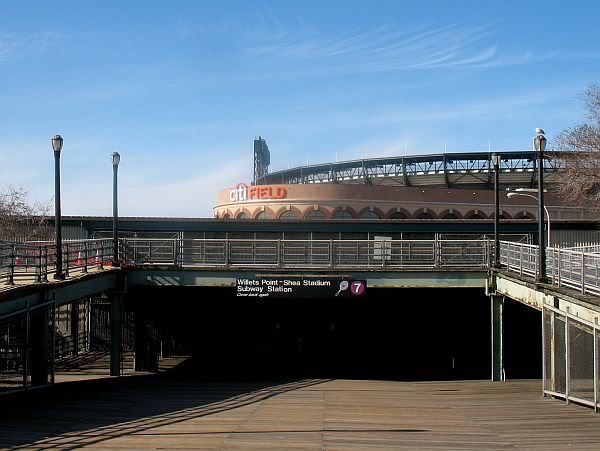
The entrance from the elevated subway was called the “Gotham Plaza Entrance” and the roofs that covered no house and seemed to be such daring architecture at the time are still there as a reminder of what once was. Roofs that once covered people seeking a little shade, packed underneath as tightly as the subway cars they just left.
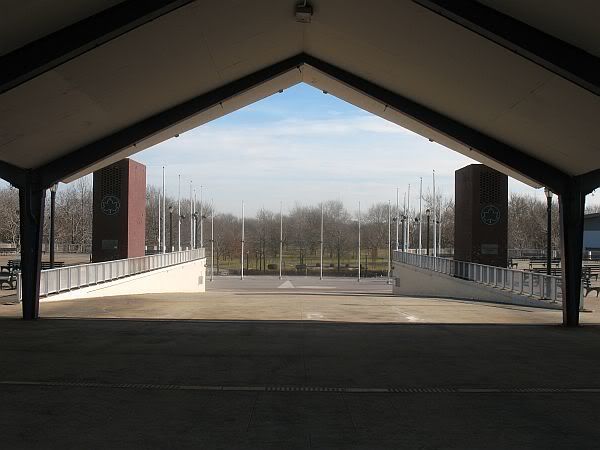
That train station still gets much use. Part of the vision of Robert Moses for a second World’s Fair was leaving behind a park that the city could be proud of. Besides the stadium, the U.S Open Tennis Center, the state of the art ice skating rink and pool that recently replaced the World’s Fair rink, the Queens Museum of Art, The New York Hall of Science, The Queens Theater in the Park, and the most impressive catering hall on earth there is boating, fishing, baseball and a whole lot of soccer.
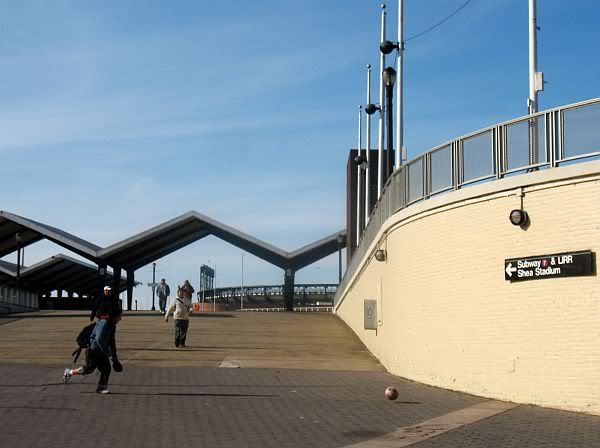
Looking forward at an almost unchanged entrance the memory of the Trylon & Perisphere, the symbol of the 1939 World’s Fair seems to be in better shape than the sixties mosaic memorabilia in the outer circle. Did you know that the Trylon & Perisphere were melted down to become World War II ordinance?
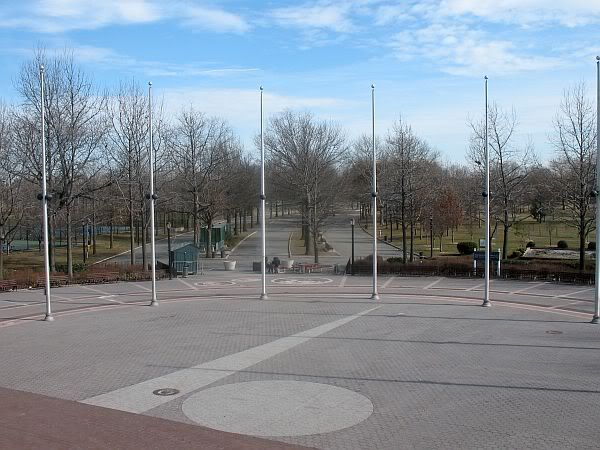
The 6 in New York World’s Fair 1964-65 seemed like it was pilfered the day before and the 9 looked like it was ripe for the pickings. It was tempting but I left it for a few more visitors.
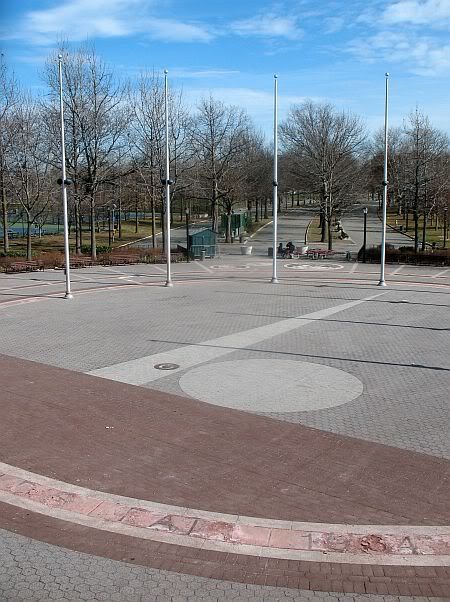
But look at the mosaic that has survived the best, a champion of both fairs, the one and only Robert Moses as presented by another one and only, Andy Warhol. Did Robert Moses really present Pop Art to the world?
Many artist including Peter Agostini, John Chamberlain, Robert Indiana, Ellsworth Kelly, Alexander Lieberman, Robert Malloy, Robert Rauschenberg and James Rosenquist were introduced to the world at the Fair and in 2004 Roy Lichtenstein’s World’s Fair Girl came back to New York.
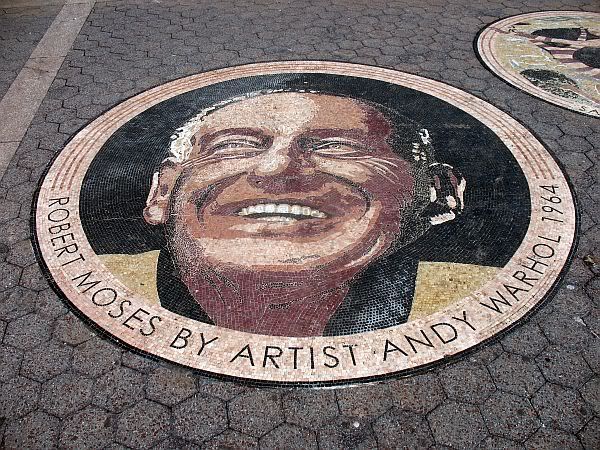
Looking down at a mosaic of a man in New York history who is almost as infamous as Boss Tweed, my doubts about most of those nasty stories came back. Robert Moses who was the most powerful man in New York politics had left the city and state with far more than Flushing Meadows. Jones Beach and Riverside Park come to mind but he had a hand in almost every public space and even redesigned Central Park for the people.
The 1964-65 World’s Fair was born in the boardrooms of rich New York businessmen. They had fond memories of the Fair in 1939 and they wanted to offer that opportunity to learn to the children of the sixties. So as I walked around seeking those childhood memories I began thinking about what the rich and powerful who learned so much about the future back in the 1960’s has to offer the children of today.
At the time Robert Moses seemed like the only man alive who could oversee such a massive project. With such a bad reputation it is almost comical now to think that he was given the job of “educating children of school age” by elected officials. Rumor has it that Robert Moses being given the job of grand czar over the World’s Fair was purely political. He was paid more than twice as much as the mayor of New York City but that condition of his World’s Fair position, the condition of giving up all of his other commissions and interest in New York, might be the main reason the World’s Fair was born. Could it be that the government gave my generation a World’s Fair just to get rid of Robert Moses?
The city and state government may have been willing to let a new age demigod mold the next generation but educate the young he did. Myself and a few million other kids are proof of that. I was eight years old that first year. That was the year that the fair was an undeniable flop. People credited the Puritanical values of Robert Moses and the fact that he gave too big a role to an entertainer of children, Walt Disney. Because Robert Moses made all of the decisions and adults did not want what Robert Moses wanted them to want, attendance for the first year was lower than expected. But he adapted and the second year had plenty of bars, some even had Go-Go Dancers.
Being eight years old I did not see anything like flop that first year. I saw magic, real genuine magic and a future with no boundaries. Oh the second year was much more fun with all the new rides but that first year was all about fun education and pure optimism.
The 1964/65 New York World’s Fair’s twin themes “Man’s Achievements in an Expanding Universe” and “A Millennium of Progress” celebrated the boundless potential of science and technology for human betterment. It was a time in America’s history that it was at the very crest of its postwar (World War II) technological and economic prowess. Americans were infatuated by the space program’s goal of landing a man on the moon, intrigued by the promise of a computer and information era, and pursuing a nuclear power program to provide electricity “too cheap to meter.”
In many ways the exhibits at the World’s Fair showcased new technological frontiers: the Space Age, the Information Age of computers and communication, the Consumer Age of new materials and products for everyday life, and the Atomic Age of electricity “too cheap to meter.” The message was of optimism with little thought to environmental or sociological consequences. The purpose was to educate the public, particularly children of school age, who were thought to be far behind the Russians in mathematical and scientific skills. It was the age of Sputnik and Americans were just catching up.
The Parker Pen Pavilion was very much in keeping with the first motto of the World’s Fair “Peace Through Understanding.” Children were assigned international pen pals and get this, you punched holes in a card about your interest and hobbies. They fed that card into a computer and the computer found an international match for you. It was eHarmony for kids in 1964!
Walking onto an outdoor theater auditorium that magically rose up into a giant typewriter ball where movies and speakers explained that all of the information in the world would someday be transformed into electronic data. IBM had a puppet show that made sense out of binary code to an eight year old in 1964. “Anybody want to play twenty questions?” Later, sitting in a Plexiglas bubble and making my first touch tone phone call I asked the guide “What are those two funny symbols for?” The answer “We don’t know but the scientist at Bell Labs say they will come up with something.” My Dad looked at me sort of funny and the guide scratched his head when I came back with “Could it be for the transfer of electronic data?” Of course I was just repeating a phrase that had just been explained to me at the IBM exhibit. We may have the Epcot Center to explain to children today what was new yesterday but this experience was very special.
Here’s an interesting look at the wayback machine, the Westinghouse Time Capsule left by the adults.
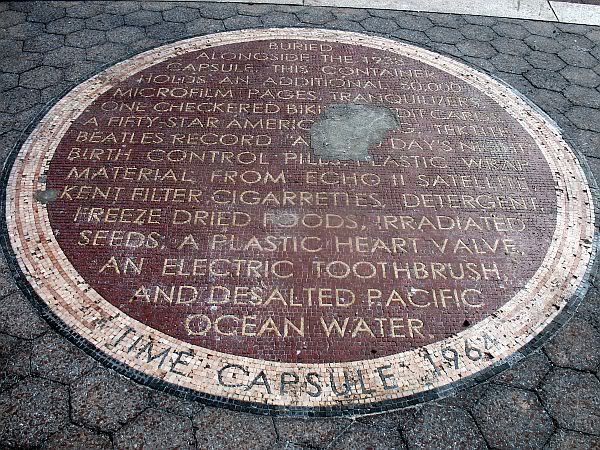
What an amazing list of representations of those times. I guess tranquilizers seemed like a necessity and perhaps the checkered bikini, at least for younger men at the time, was one of the causes. Well the birth control pill was certainly an important development but the time capsule needed a carton of smokes? Plastic wrap, irradiated seeds and freeze dried food may have seemed like accomplishments of the time but it was awful nice of them to toss in A Hard Day’s Night.
In some way those times seem more progressive than today. Most of those corporate educational exhibits presented a walk through evolution. With the many church pavilions, creation and a five thousand year old earth was presented side by side with the scientific explanation and a five billion year old earth. I don’t recall any controversy or right wing religions protesting Walt Disney’s presentation of the cretaceous era.
Another sign of reverse progress, I noticed that every statue I saw had either been well maintained of had gotten a face lift except for one, the one with the naked lady. The statue by Marshall Fredericks is called Freedom of the Human Spirit.
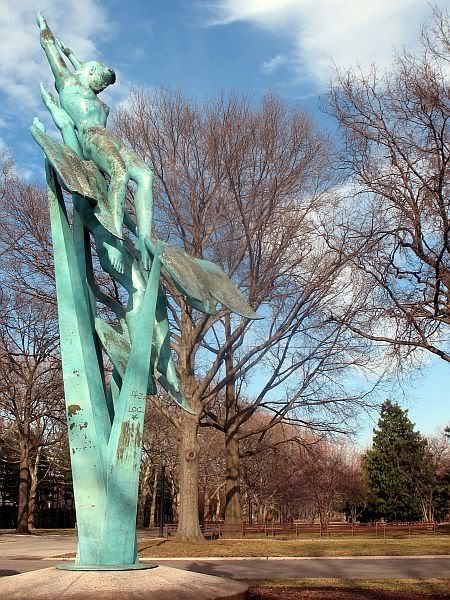
Well you can’t expect Rudy Giuliani or Michael Bloomberg to shell out any cash on exposed breast, can you? By the way, that naked lady that now has her hands stretched towards Arther Ashe stadium had her arms pointed during the World’s Fair, when John Ashcroft was only twenty-two years old, that naked lady had her arms pointed towards the United States Pavilion.
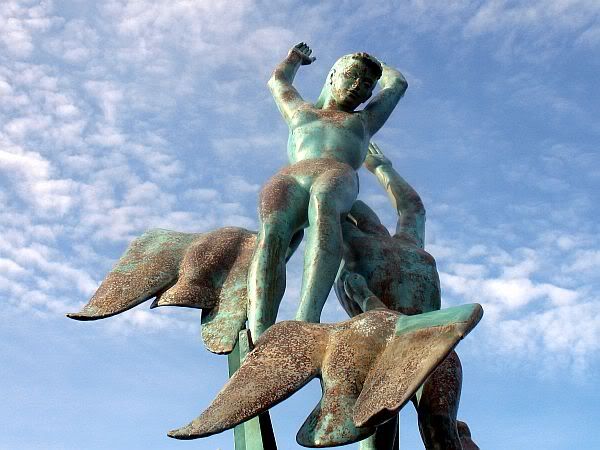
Here is another set of entrance tiles to commemorate one of the buildings that Robert Moses made sure would be permanent. A Hall of Science to educate New York children for many years to come. I once sat inside one of the many space capsules there pretending I was John Glenn and dreamed of going to the moon.
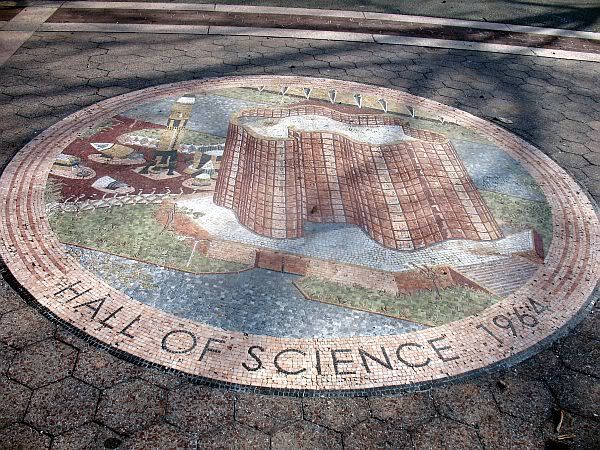
Here is a very fond memory, the Fountain of the Planets.
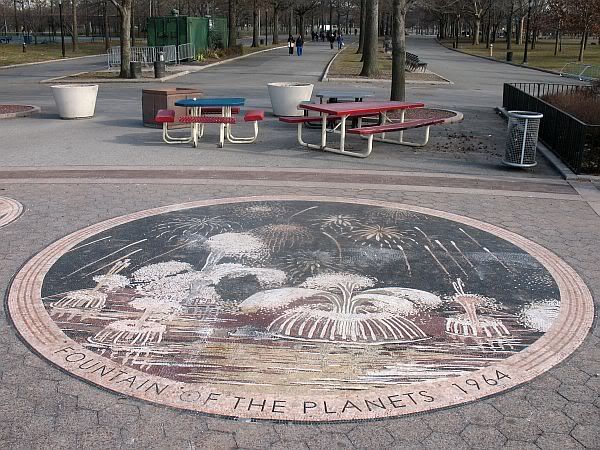
Oh does that bring back memories. Apparently the music of “Rhapsody in blue” was a particular favorite of the crowds. Picture the Bellagio Fountains before the invention of dancing water jets. Wow, Robert Moses even outdid himself with that amazing fountain. Some of the water jets shot shot 625 feet into the air and outsides of advanced technology Steve Winn’s show show had nothing on the Fountain of the Planets. Someone named Pierce has quite a collection of stills from the Worlds Fair and this still captures the fountain during that time.
For me, when I arrived at the lost fountain that sits inside a pedestrian street once called the Avenue of Industry, the view was very different but my childhood came back strong.
Created for the 1963-64 World’s Fair, and “a relic to the grandiosity of the time,” according to Parks Commissioner Henry J. Stern, the fountain is 625 feet high when spraying at full height, only 50 feet shorter than Shea Stadium. It was one of the vast and vastly expensive projects that Robert Moses, the powerful Parks commissioner, created as a monument to himself and his achievements.
Back then, the fountain was impressive — some say breathtaking — with a high-arcing geyser glistening in multicolored lights. Now it is a dirty, mucky swamp.
The water is nearly stagnant. Algae flourish, coating the water in a solid-looking mass. Empty water bottles, soda cans and miscellaneous litter clog the surface. A few months ago, Bryan Pu-Folkes, a lawyer who lives nearby and who is pressuring city officials to clean it, found a dead swan and a dead turtle floating in the muck.
As I looked at the railing and remembered that top rail at the level of my chin, fond memories. The fencing was not there back then, just those bending horizontal rails and the curved aluminum post that held the rails. Vision of myself and my two siblings hiding under the curve and poking our little heads through the railing were overwhelming.
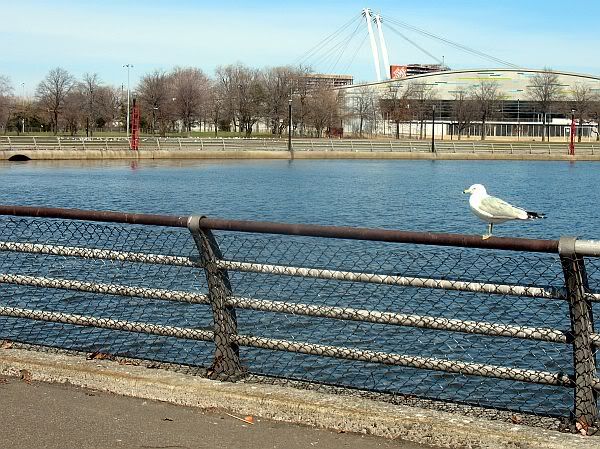
All of those three lane streets remain. The crowds I once dodged in and out of from amazing achievements in science to walks down simulated European street scenes and western towns are gone, taken over by geese. I couldn’t help looking and remembering the sky rides overhead with the sound of helicopters even higher with the Beatles playing everywhere you went. Those trees must have been much smaller back then. The space age golf carts for the privileged and the ultra modern Greyhound trams for the rest of us are just a memory but what memories!
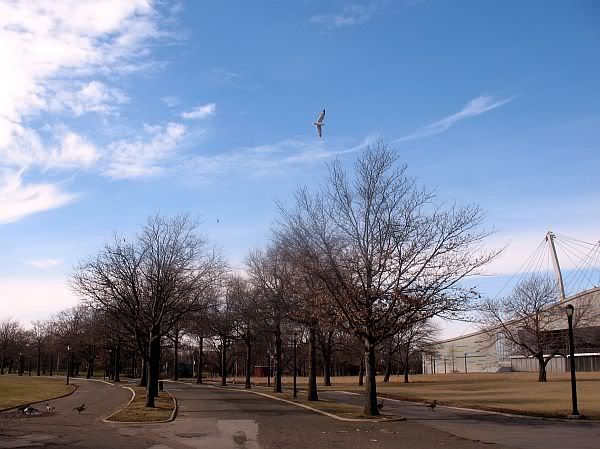
So what can you find today? I think this is an interesting sight. It may be the second most utilized park in New York City but there are still as many water fountains as the time when the park could welcome a million visitors in one day. Today the soccer players must appreciate so many water fountains on a time out. That is if the fountains work and the bottled water makers haven’t convinced the players that New York drinking water is unsafe.
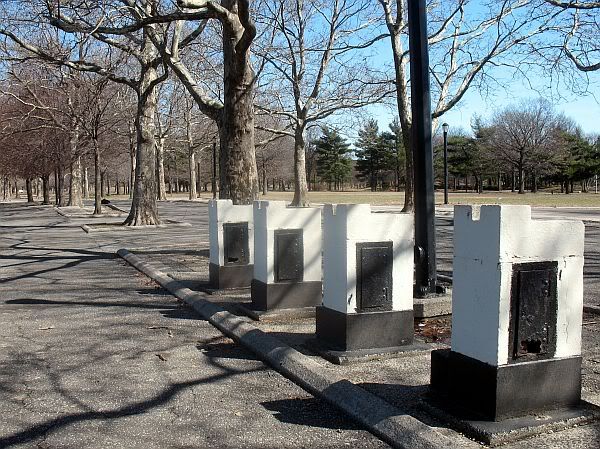
Here this is a little more impressive. The very old meets the not so old. At another webpage dedicated to what is left at the park I read that this column is the second oldest thing that is outdoors in New York City (with Cleopatra’s Needle being the first) but I don’t think it gets much attention;
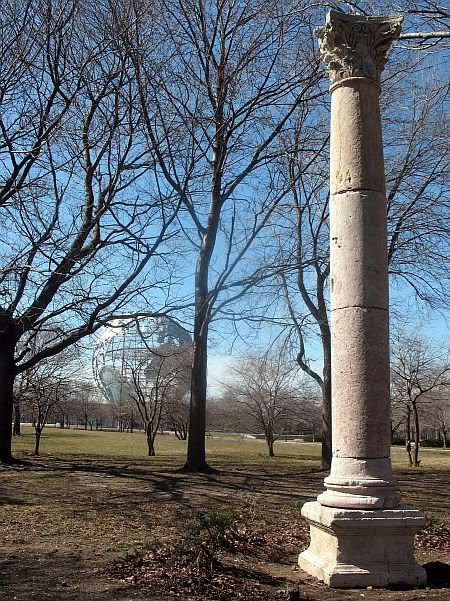
I scraped away some leaves from a stone on the ground and read this;
THIS COLUMN WAS PRESENTED TO THE NEW YORK WORLDS FAIR AND THE CITY OF NEW YORK BY HIS MAJESTY KING HUSSEIN OF THE HACHAMITE KINGDOM OF JORDAN ON THE OCCASION OF JORDAN’S PARTICIPATION IN THE FAIR.
THE COLUMN WAS RECEIVED BY THE HON. ROBERT MOSES, PRESIDENT, NEW YORK WORLDS FAIR 1964-65 CORP.
THIS IS ONE OF MANY COLUMNS IN A TEMPLE ERECTED BY THE ROMANS IN 120 A.D. THAT STOOD IN THE ROMAN CITY OF JERASH.
THE COLUMNS ARE KNOWN AS THE WHISPERING COLUMNS OF JERASH.
Somewhere in between the Unisphere and the Whispering Columns of Jerash is a bench reminding me of many viewings where I was not even able to whisper. As an eight year old I was was mighty impressed with the sight of my first Michelangelo.

The 1964-65 New York World’s Fair was not officially sanctioned. Some think that was because it happened so soon after the Seattle World’s Fair but that was not the only reason.
It was understood from the very beginning that official sanction by the Paris based Bureau of International Expositions would not be forthcoming. Their requirements that the fair take place within a single year and that each country be given 5,000 square feet of space rent free could not be met. It became difficult to persuade foreign nations to build national pavilions at the Fair.
It wasn’t a big enough disagreement with the French as to officially sanction the “Freedom Fry.” While only Spain, Switzerland, Belgium, Austria and Sweden represented Europe in the first year and of course given the time Russia and her satellites had nothing to do with it, Robert Moses used his influence to get 36 nations to participate, filled in the blanks with State Pavilions and amazing presentations from U.S. industry. World’s religions got in rent free and fifteen denominations participated. There was a running gag about the replica of the Salt Lake City headquarters of the Church of Jesus Christ of Latter Day Saints trying to outdo the Vatican but they didn’t have La Pietà.
There was a huge difference between the first and second year. Great Britain did have an exhibit for 1965 that can still be viewed today. One of the many legacies of Robert Moses was the Queens Zoo in the south end of the park. The Winston Churchill Pavilion that was housed in A Buckminster Fuller geodesic dome is now an aviary in the Queens Zoo.
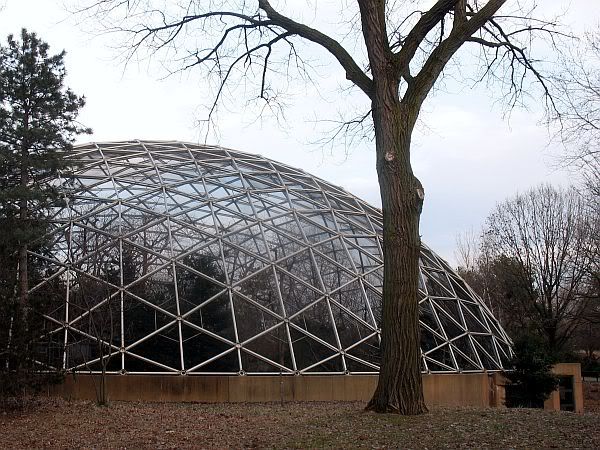
And another ray of sunshine lies to the north of the original fair grounds. There was a huge garbage dump there and it was arraigned so that when the grounds were returned to the Dept. of Parks all of the trees, shrubs and plants that were donated from many nations would be moved there and a botanical gardens was born.

Where the Queens Botanical Gardens was born from a garbage dump was actually part of the 1939 World’s Fair. It was the Court of Peace but by 1964 it was a forgotten landfill cut off from the fair by the Van Wyck Expressway.
And then there’s this. Who knew? I have a garden. I’ll have to find that friend and say thank you.

But wait there’s more. Besides the marina that was a product of the recent World’s Fair you can find a wetlands preserve at the site of the both the 1939 Billy Rose Aquacade and the 1964 Water Show.

Underneath the counter to the new concession stand, a part of a very impressive public esplanade that replaced the 1939 concrete grandstands for the water shows, you can find a relief to capture times gone by.
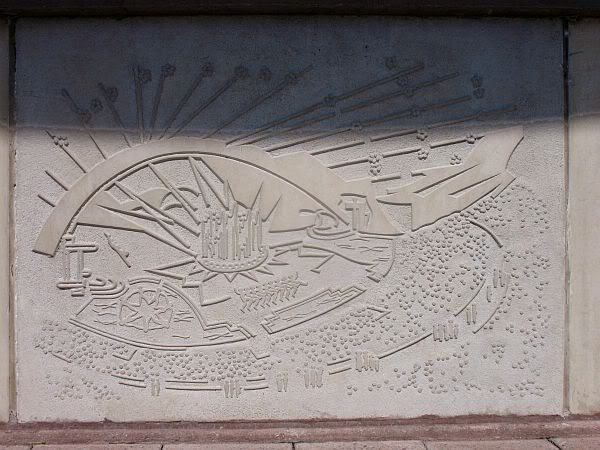
And walking back from the Aquacade across one of those bridges that were once filled with people, a scene from the movie “Men in Black.”
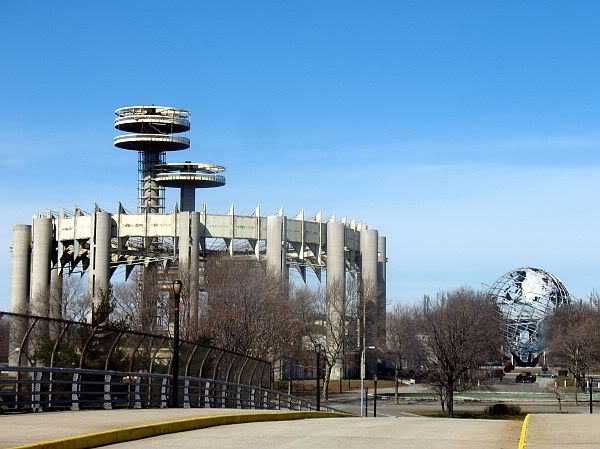
Here is a view I once enjoyed from the top of the New York State Pavilion. This is a photo of a photo that can be found in a small gallery in the Central Park Armory.
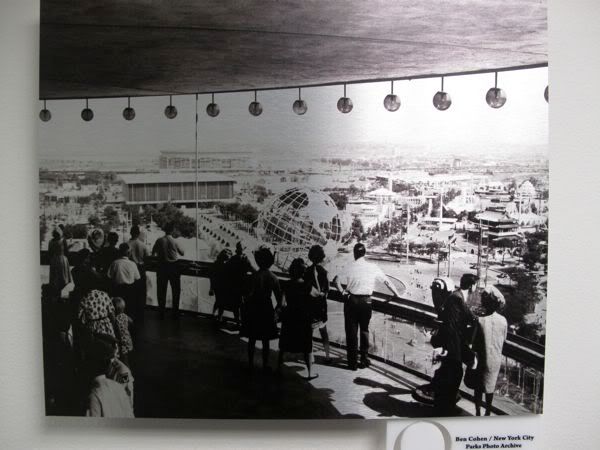
And those towers as they appear today.
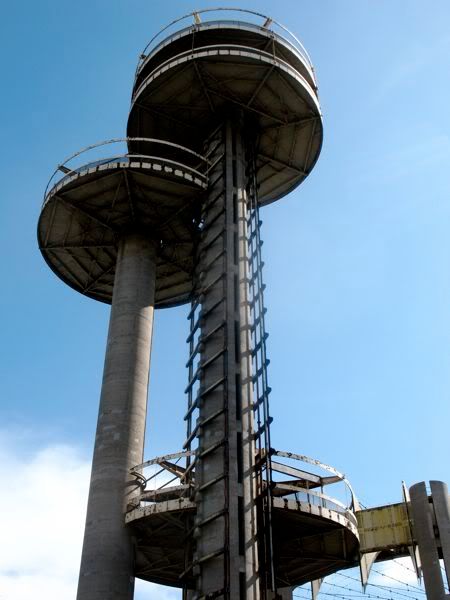
Not everything that Robert Moses touched at the World’s Fair turned to gold. He made the mistake of greatly overestimating the government of New York When he commissioned Phillip Johnson to design and convince Texaco to pay for a giant terrazzo map of the state. The New York State Pavilion was meant to be permanent but this is New York.
The “Tent of Tomorrow” was the heart of Johnson’s pavilion. An elliptical shaped, 350-foot by 250-foot structure, whose outer support of sixteen 100-foot tall, white concrete columns, made it one of the largest buildings at the Fair. The Tent featured the world’s largest suspension roof. And on the floor, the world’s largest road map – the State of New York done in terrazzo. After all, this was Nelson Rockefeller’s New York State Pavilion showcasing his state. Everything was required to be the tallest, the largest and the best.
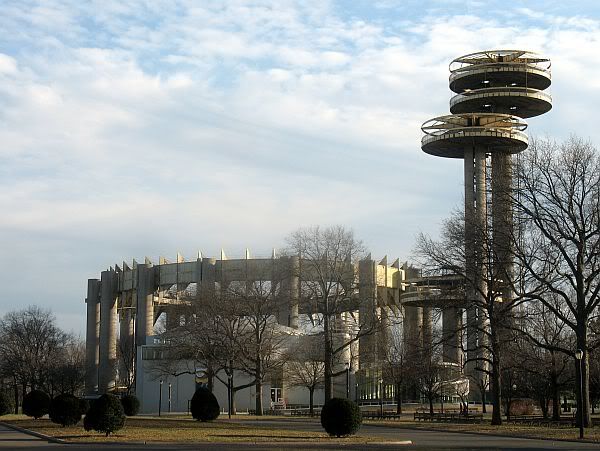
That breathtaking structure was suppose to be a tourist attraction that would represent the state for generations. But only in New York, a Bird Brain State and City, could the tallest, the largest and the best revive such treatment.

While actually made from fiberglass the ceiling that was called “The Tent of Tomorrow” was the largest piece of stained glass on earth. It is impossible to describe the giant light show that began in the west when the sun rose in the east and moved east until sunset. It was sort of a modern day sundial and at high noon there was an age appropriate psychedelic light show on the grounds of the World’s Fair. This was where largest piece of stained glass on earth was.
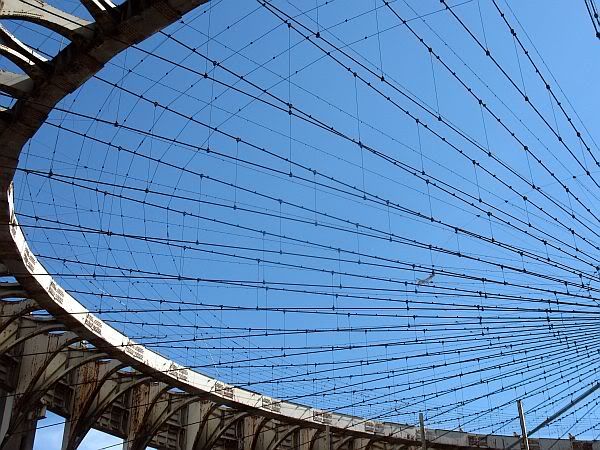
Can you imagine any other state being in possession of the largest piece of stained glass on earth and deliberately destroying it because that was cheaper than maintaining a work of art. Can you imagine taking possession of a piece of architecture by one of the preeminent architect of the 20th Century and letting it rot?
Some are much kinder than I about the treatment of this representation of New York.
Efforts have been made to save the Pavilion by using it once again, and at least one of them has been successful. The Queens Theatre took over the circular Circarama adjacent to the towers in 1994 and continues to operate there. As for the rest of the Pavilion, many uses have been proposed, including an air and space museum but no concrete plans have been made for the decaying structure yet. As a result, the towers and the large elliptical plaza that was once covered remain unused and padlocked (in the day of my visit, a worker was kind enough to let me enter briefly). The map of the state of New York, which was open to the public until sometime in the 1980’s, is almost completely destroyed in some areas, since it is now unprotected from the elements (as are badly rusted escalators and handrails) and lays literally in pieces. Inside, large red stripes that were painted on the walls can still be seen, along with round planters/benches that surrounded the map. As it stands today, the Pavilion is a beautiful structure, perhaps one of my favorites in all of New York City. The Pavilion is a fantastic mix of architectural optimism from another time, with the financial realities of a city like New York.
I did not meet a worker who was kind enough but I poked the camera in through a fence.
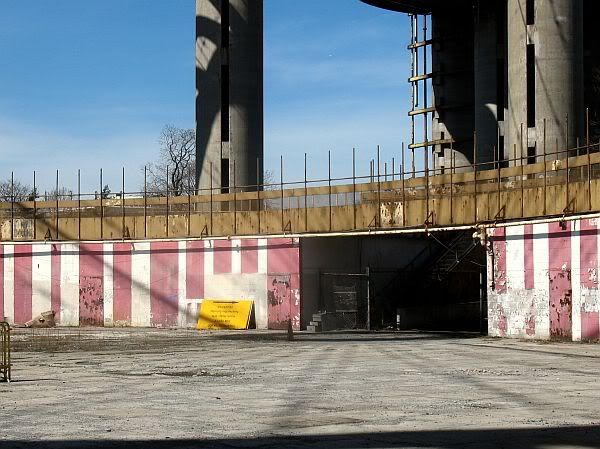
In that decaying edifice lies my assessment of the city and state where I pay my taxes and I’m waiting for the day that some bureaucrat makes the announcement that the New York Pavilion can no longer be saved. I’m sure that will be followed by “and because of the nature of the building it will cost…” followed by some figure that is three or four times the amount of the many salvage plans that so many New Yorkers lobbied for over the years.
It is no surprise that in a city that refuses to even provide public bathrooms the most often heard expression is “What are you gonna do?” There is still a movement to save the New York State Pavilionas an Aerospace museum and another to perserve the park’s rich history but both seem to be going nowhere. The response from the same Parks commissioner who oversaw the destruction of the roof was about what a New Yorker can expect.
This significant structure is in serious jeopardy of being demolished, even while a plan is being proposed to save it! It will collapse or be destroyed very soon (we’re talking weeks, not years). Please speak up now and help the developers adapt this building for a new use while saving and maintaining it’s historic design concept. The timing is critical!
Dr. Charles Aybar, an aviation executive, and Frankie Campione, Principal of CREATE in Manhattan, offer an exciting plan to save this pavilion and adapt it for modern use as an Air & Space Museum. But even with a viable plan on the table, Parks Commissioner Henry Stern (the building’s “landlord”) reportedly said he’d like to budget money to tear the “Tent of Tomorrow” down because it serves no useful purpose. This coming AFTER this proposal to save it!
In fairness the 1970’s were a rough period for New York City. It was on Ed Koch’s watch when the Department of Parks transformed the Tent of Tomorrow into the Tent of Yesterday but the last Democratic mayor David Dinkins ended the practice of maintaining only Manhattan parks and the city parks are all in much better shape now. Perhaps because he started in Brooklyn and moved to Garden City at age seven but Rudolph Giuliani was the mayor who did a little something about the New York Pavilion. As a matter of fact it was during the Giuliani administration that the bulk of Flushing Meadows upgrades took place. There is a glimmer of hope for the giant map I followed as a child and who knows, with that old Koch holdover Henry Stern out of the way, perhaps a phoenix will rise up again out of the ashes of New York City government.
If anyone is referring to the New York State Pavilion when the say “What a waste” I have to agree. But some of those memories didn’t go to waste. Walt Disney was not the only person to get his act together and take it on the road. According to the Wiki 1964 New York World’s Fair page you can visit the World’s Fair all across the nation.
Like its predecessor, the 1964/1965 New York World’s Fair lost money. It was unable to repay its financial backers their investment and it became embroiled in legal disputes with its creditors until 1970, when the books were finally closed and the New York World’s Fair 1964-1965 Corporation was dissolved. Most of the pavilions constructed for the Fair were demolished within six months following the Fair’s close. While only a handful of pavilions survived, some of them traveled great distances and found reuse following the Fair:
- The Austria pavilion became a ski lodge in western New York.
- The Wisconsin pavilion’s front tee-pee-like portion became a radio station in Neillsville, Wisconsin. The pavilion’s large rear structure that formed a squat-looking “H” (if seen from above) is the combined kitchen, dining hall, and recreation hall of Camp Ramah in upstate Lakewood, Pennsylvania.
- The US Royal Tire-shaped Ferris wheel was relocated to become a road sign along Interstate 94 in the Metro Detroit Downriver community of Allen Park, MI.
- The Pavilion of Spain relocated to St. Louis, Missouri and is now a part of a Hilton Hotel.
- The Parker Pen pavilion became offices for the Lodge of Four Seasons in Lake of the Ozarks, Missouri.
- The Johnson Wax disc-shaped theater was reworked and became part of the S.C. Johnson Wax complex in Racine, Wisconsin designed by Frank Lloyd Wright.
- The stained glass windows from the Vatican pavilion were built into Saint Mary’s Church in Groton, Connecticut.
- The Christian Science pavilion became a church in Poway, California. The structure was demolished in 2006.
- The Mormon pavilion became a church in Plainview, New York, dedicated December 2, 1967 and still in use.
- A large oil painting of a woman, painted in 1964 by Roy Lichtenstein and titled “New York World’s Fair,” is in the Weisman Art Museum in Minneapolis, Minnesota.
- The Carillon from the Coca-Cola Pavilion was moved to Stone Mountain Park, near Atlanta, Georgia.
- As noted, the Disney-created attraction “it’s a small world” was transferred to Disneyland, along with the “Carousel of Progress” and the first Abraham Lincoln audio-animatronic figure for the original “Great Moments With Mr. Lincoln” Show. Scenes from the Ford Magic Skyway were used in the Disneyland Railroad‘s Primeval World Diorama and the attraction’s actual ride system was improved upon and used for Tomorrowland’s PeopleMover.
- Some of the light fixtures that lined the walkways can be found still functioning at Penn Hills Resort in the Poconos, Analomink, PA, the Orange County Fairgrounds in Middletown, NY and Canobie Lake Park in Salem, NH.
New York City was left with a much improved Flushing Meadows Park following the Fair, taking possession of the Park from the Fair Corporation in June, 1967. It is heavily used for both walking and recreation. The paths and their names remain almost unchanged from the days of the Fair.
And then there’s the legacy of legacies, they don’t call it stainless steel for nothing. The Unisphere has become the symbol of Queens and being a favorite of Hollywood has seen much better treatment than the New York State Pavilion.
Designed by landscape architect Gilmore D. Clarke, the Unisphere was donated by the United States Steel Corporation and constructed by that company’s American Bridge Division. It is the world’s largest global structure, rising 140 feet and weighing 700,000 pounds. Some sources say the Unisphere weighs 900,000 pounds, a figure which includes the additional weight of its 100-ton inverted tripod base. The diameter of the sphere itself is 120 feet, or 36.57 meters. It is constructed of Type 304L Stainless Steel.
Built on the structural foundation that supported the 1939/1940 New York World’s Fair’s Perisphere, Unisphere is centered in a large, circular reflecting pool and is surrounded by a series of water-jet fountains designed to obscure its tripod pedestal. The effect is meant to make Unisphere appear as if it is floating in space.
Those fountain jets along with the nozzles in the reflecting pools between the Unisphere and the Fountain of the Planets are still there. Even the center structure of the Fountain of the Planets is has been left intact. It seems that almost every fountain has been left for something other than skatboarders and the Department of Parks keeps painting them sky blue because they are turned on each year for the U.S. Open. Perhaps they could be turned on again through the warm weather months someday, one can dream.
The World’s Fair was and still is an excellent lesson in geography. Hey that Pacific Ocean really is big. Oh and the answer to what those three represent, to the best of my knowledge the rings seem represent Yuri A. Gagarin, John Glenn and Telstar. It was the space age.
I find the view of dark underbelly of the United States to be interesting.
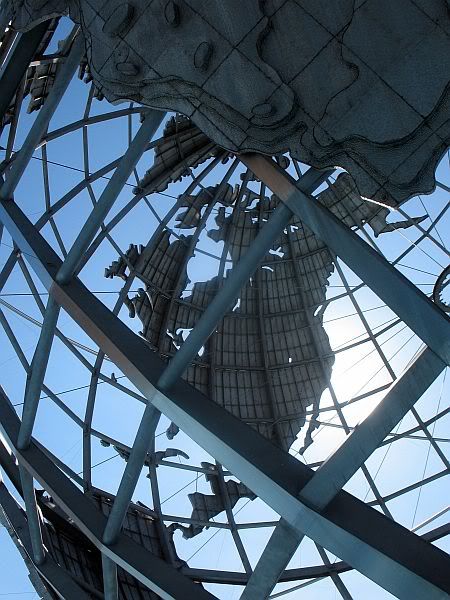
The view of the vast Pacific Ocean looking back to the Fountain of the Planets from the Queens Museum.
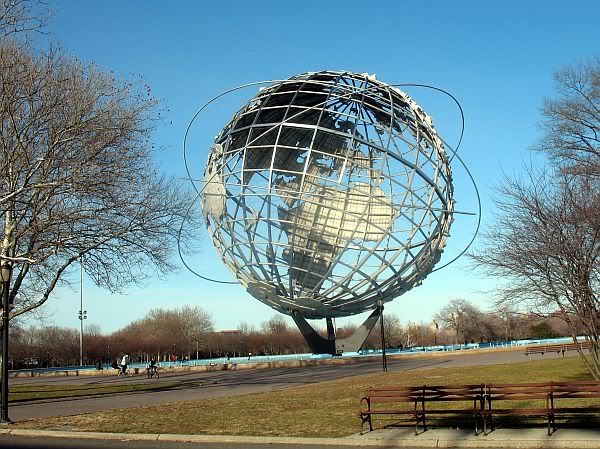
And one more of the soaring naked lady with her view of the Indian Ocean.

The long view over fountains now utilized by skateboarders of Throwing Rockets, Africa and The Queens Museum from the crescent shaped Fountain of the Planets.
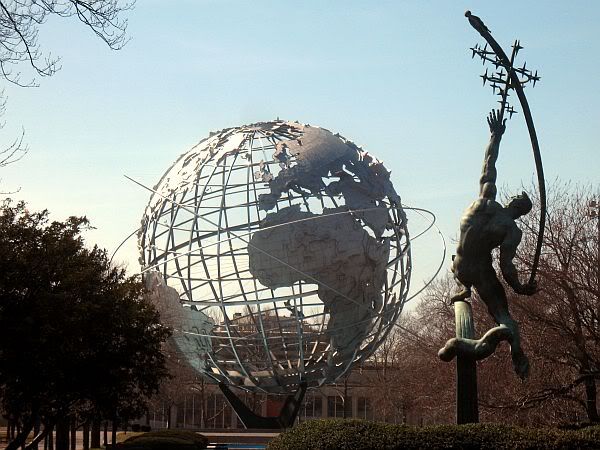
In between Rocket Thrower and the Unisphere is a new addition to the park that is very intriguing. There is an Edged Granite Pavement that is a collection of abstract pictographs but not so abstract that you can’t figure out what you are seeing. Just wimsical enough to keep you busy. Unless you cheat and bring both World’s Fair maps with you, it makes a fun guessing game.
New York-based artist Matt Mullican (b. 1951) created this granite panel on which is etched the history of Flushing Meadows-Corona Park’s development, from prehistoric times through the World’s Fairs of 1939-40 and 1964-65. The 3,000-square-foot tableau consists of 464 four foot by four foot etched blocks that tell a hieroglyphic-like story of the park site, including the technological advances showcased in both World’s Fairs. The piece was installed in 1995…
I could not figure out how to take a picture of this huge granite slab but on my last visit as I was interacting with the hieroglyphic-like symbols a twelve year old walked up to me and asked “Hey Mister, can you tell me what this all means?” By the end of my lengthy explanation where I did more listening than talking it seemed like I was holding court with about thirty skateboarders and roller skaters. Their input was amazing. Young minds seem able to grasp anything and I got the feeling that they would all spend the evening surfing many of the World’s Fair websites. Perhaps the internet fills in for world’s fairs today but that seems so isolated compared with my memories. My favorite question from that encounter “So you’re saying that toasters and washing machines were a really big deal back in 1964?”
Of course that museum holds a very interesting artifact from 1964. The giant diorama of the city was in the news the week I visited because Little Shea was going, going gone. The World Trade Center is still standing until the Freedom Tower is finished but Citifield is on the map. Too bad Robert Moses isn’t still around to oversee the building of the Freedom Tower. On the tenth anniversary of one of the darkest days in New York City history, there will still be a hole in the ground where the World Trade Center once stood.
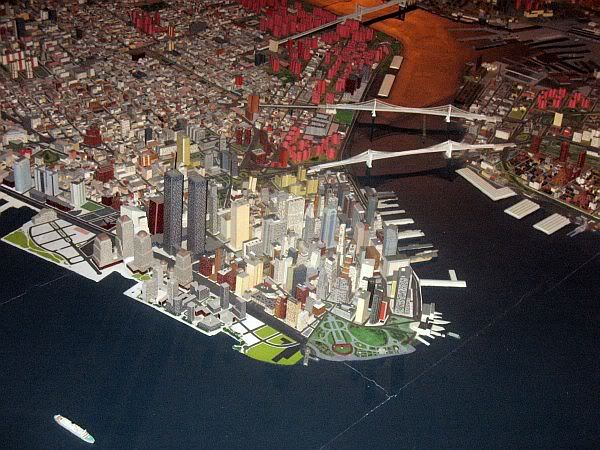
If there is anything that is a feather in the cap of Robert Moses it is that New York Hall of Science to explain what is a big deal today and the adjacent space park to explain what was.
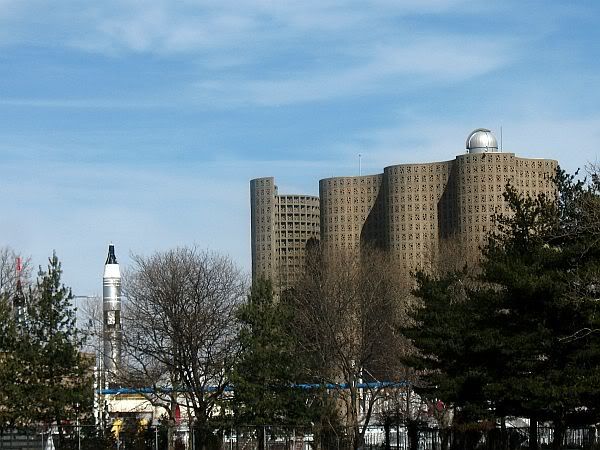
And next door the old Port Authority building that is now a catering hall and was once a heliport. The World’s Fair was well before the tragedy on the roof of the PanAm building and wealthy people actually flew to the fair from Manhattan to land on that rooftop. Talk about traveling in style, what a view!

If someone wants to argue that there was little thought of the impact on the environment and that the master road builder ignored public transportation to showcase the automobile, they will get no argument from me. One of those paths that still has road signs for the fair, the most impressive of my youth is called the Avenue of Transportation. When Robert Moses took over the second World’s Fair and added “Man’s Achievements in an Expanding Universe” to the original theme “Peace through Understanding” his close ties with automakers helped mold a generation of automobile lovers.
In 1939 General Motors offered Futurama where they predicted better farming through chemistry, cheaper power through hydroelectricity and the superhighway making life better for all. A new world where labor is replaced by machinery. Here’s a youtube of the 1939 exhibit.
Twenty-five years later on the 300 anniversary of the booting the Dutch out and changing New Amsterdam to New York, GM has new ideas. The video of Futurerame II shows that the largest company in the world still predicted a future that they would help mold. Sterile skyscraper cities with adequate underground parking, highways on the moon and drilling into the continental shelf for oil. There was vacation hotels at the bottom of the ocean and they were even going to populate Antarctica. Well the laser beams that leveled the trees of the tropical rain forest didn’t come true but still my eight year old eyes marveled at the thought of forest highways “bringing the goods and materials of progress and prosperity to the innermost depths of the tropic world.”
Futurama’s designers became carried away with a design of a three-football-field long, five-story-high atomic powered jungle road builder. They envisioned that it could make one mile of elevated four-lane highway each hour, twenty-four hours per day. A 100 foot long insectiform laser tree cutter preceded the road builder, and it sprayed the cleared areas with chemicals to retard growth. While projects like this were well thought out, it was long before environmentalists thought of the consequences.
Even back then when I was eight years old GM seemed pretty silly. Ford had a better idea. Besides the fact that the Ford Mustang sitting outside was probably my first experience with lust, the whole family could get in one for an amazing voyage. It may seem a bit corny now but on YouTube Walt Disney can still take you on a guided tour of the Ford Magic Skyway with an introduction from Henry Ford.
Nostalgia for the fair has a big footprint on the web. A man named Major Pepperidge has some wonderful blog pages. On this page he claims that the Ford Magic Skyway looked like “a giant habitrail.” So true and look at this amazing photo that he offers.
This other page from Major Pepperidge offers three more amazing photos that will open to full size. The first makes a good comparison with my present day main entrance photos. The second shows the RCA studios where people could learn about and see themselves on TV. The third is a photo of the Astral Fountain and offers a sliver of the Tent of Tomorrow.
There are so many ways to go back now. On this mapsite you can open individual maps and click on the pictures to see what was there. A Goggle photo search seems endless. My favorite that can be browsed for hours is nywf64.com that never seems to end. Much information in this diary came from this memorabilia site and you can still find many of the picture postcards from that era.
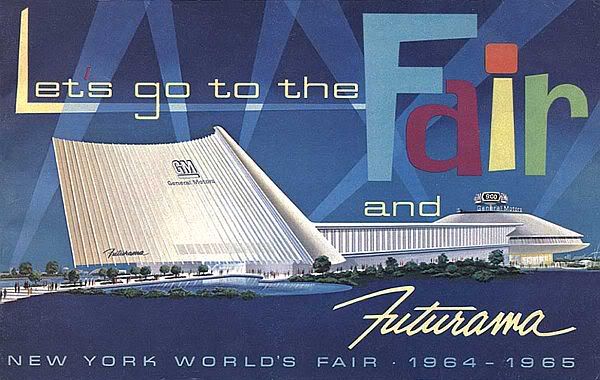
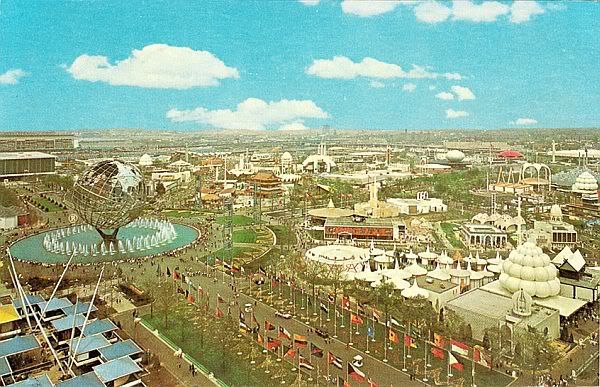

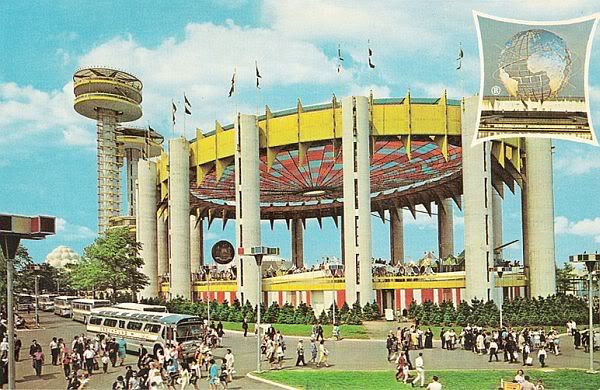
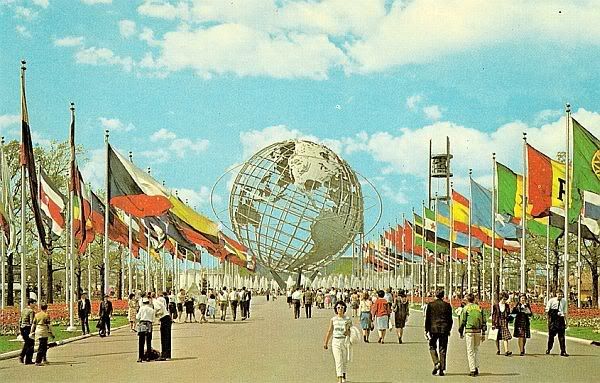
And returning to the present day. The colors of the New York World’s Fair just like the Mets and the original Shea Stadium were blue and orange.

Somehow those became my two favorite colors. During my recent visit I looked everywhere for blue and orange. The only place I could find those colors was a gate to Shea’s anagrams. Arthur Ashe stadium now beautifies a former ash disposal site with just a hint of what once was.

At the end of the day, a year ago today after a thought provoking walk I started thinking about how great that park is for the people. Young people today are enjoying a gift of Robert Moses. I got the feeling that many of the things I’ve heard about one man might be misleading.



Talk about going the distance. In order to get his hands on a second World’s Fair Robert Moses had to prove to the city that on the second go round the fair would make money. He knew that wasn’t going to happen but being dissatisfied with what happened to the park after the 1939 Fair and wanting another chance at educating children of school age he did cook the books. When it came to the World’s Fair my father having a job there sort of made me a child of privilege. I got to see the fair before it was opened to the public, I got to see it many more times than most kids and I was also out there a few times during the demolition. Hanging around the adults who worked there I heard a few things and everyone of those blue collar workers seemed to know that Robert Moses presented the city with some “cooked books” before the fair even opened. I still find it amazing that Robert Moses could fool the entire government but he could not pull the wool over the eyes of the construction workers. Or perhaps the government knew from the very beginning and had the upcoming trials about a retired man’s bookkeeping planned from the start. Who knows?
What’s that saying “If you don’t do anything, you can’t do anything wrong.” I keep thinking about the people who accomplished much in New York. Once a year during the AL Smith dinner I hear so many New Yorkers say “Wasn’t he a reporter?” On a national level Robert Moses clashed several times with my favorite President of all time but they were both New Yorkers who did much and look how hard the government has worked to preserve the legacy of Franklin Delano Roosevelt.
I know I’ve been a New Yorker all of my like and I’ve heard so many bad stories about a man who was no angel but sure did a lot for the people. I think the next time I’m driving out to Jones Beach and someone says “You know the reason the bridges are so low is because Robert Moses didn’t want the bus dependent African Americans to come out here?” I’ll say “Yea bigotry was so rare in his day but where are we driving?” When driving on the Cross Bronx Expressway I always hear “This road ruined the Bronx.” I could come back with “Lets’ say that not enforcing occupancy laws and allowing the slumlords to get away with so much that the tenants started to burn down their own homes as a means of forcing the city government to provide decent housing was not the cause. Perhaps not investing anything in the South Bronx for decades except for building new garbage dumps and not even fixing the public streets was not the reason. Maybe the demise of the Bronx was caused by the government concentrating the Police force in “better neighborhoods” and leaving the Bronx to burn. Perhaps the truce between the NYPD and the hookers of the city that they could do their business just as long as they stayed on Simpson St. and the drug dealers that they keep the sales on Brook Ave. was a cause for demise. Perhaps a government that offered one tax incentive after another to Manhattan businesses and told the South Bronx factories ‘you get nothing’ was the cause of the whole industrial section where many Bronx residents made a living turning into a ghost town. But you’re right, not investing anything in the South Bronx for decades except for building new garbage dumps and not even fixing the public streets was small potatoes compared with an expressway.'” And when someone tells me “It was Robert Moses who forced the Dodgers and Giants out of New York” I’ll just say what I’ve always said.“Lets Go Mets!”
And did you exchange a walk on part in the war for a lead role in a cage?

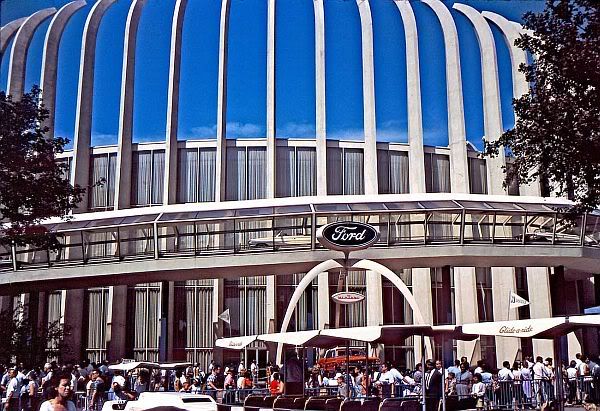
15 comments
Skip to comment form
Author
I had contacted the owner of GORILLAS DON’T BLOG for permission to use that amazing photo of the Ford Pavilion above. He got back to me with far more amazing photos, three that he stitched together to make panoramas of the park.
He also sent me five other great photos, Ford, Chrysler, Beyond the Moon, Progressland and Pepsi.
Author
I have one World’s Fair souvenir. Growing up in a household with a Dad who worked there was all sorts of World’s Fare gak and I had one of these that was free.
It got taped up on the wall and disappeared at the next paint job. I saw it in the 1990’s at a poster fair. It was before the eBay days and I paid way too much for it but I’m glad I did.
…but when it closed, not when it opened.
This is a tremendous work, thank you. I find the level of civilization and optimistic spirit that we once had to be the saddest thing that we have lost over the last few decades. These images reflect a time when America was still great, and there was no limit on what we could accomplish.
The art-deco splendor of the 1933 World’s Fair is also worth a shout out.
http://www.radiostratosphere.c…
Author
I put up temper tantrums when my Dad wouldn’t take me out to the fair the second year. Toward the end of the summer I ended up going out there everyday. I was very big for nine years old and it wasn’t long before I was working his spotlight at the Texas Music Hall.
I would ride in with Dad early in the morning and wonder around the fair all day by myself. I know that sounds like child neglect today but times were different. With a few dimes in my pocket I saw few things. The television that talked back to the people, me and him we were on a first name basis.
There were many things that you had to pay to get into and since my Dad knew a few people there were some paid exhibits that I got into “on the arm” One of these was a demolition derby that I went to over and over again but most of my memories are of the free exhibits.
I would meet dad for dinner and since he didn’t like me wondering around at night I spent every evening on a catwalk above the audience at the Texas Music Hall. Eventually I started running my Dad’s light.
Now do you remember how Texans always needed to prove that everything was bigger in Texas? Well this was a chorus line of dancing ladies that were all shaped like Dolly Parton. That didn’t mean much to me at the time. I just noticed that women from Texas were big.
Now on those carbon arc spotlights, just like the ones today there are three levers on the top the lever that is furthest from the stage is a dowser for dimming, opening and closing the light. The middle is a cutter for getting the light off the audience when you have a wide spot. The third handle is the iris for going wide or narrow.
One night on a blackout I got mixed up and instead of using the dowser I grabbed and closed the iris. The smallest an Iris will get is not a blackout. Instead it is a very narrow and very bright light.
I was following the center dancer with the biggest breast and when all of the lights went out there was only one light that was lit in the auditorium.
It was mine and it had a pin spot on an enormous cleavage. Since it was the only light the audience went into hysterical laughter. I didn’t see what was so funny but I knew it was time to get embarrassed.
Ten years later I started working in the same business for real. It was ten years but on my first day someone who worked there walked up to me and said “Hey Pinspot.” After that as an introduction he told all of my co-workers that seemingly ancient story. Pinspot probably would have become my nickname but I was also sort of big for my age at nineteen.
You should have seen the look on my boss’s face when he asked me if I knew how to run a spotlight. At nineteen I said “Sure but I’m a little rusty since it’s been a few years.”
to finish reading and it has taken me several hours to write a comment. I spent quite a lot of time at the Fair those two summers with the man who became my first husband. He had friends at the Israel Pavilion and we would meet up with them on Saturday night after sundown to eat, drink, sing and dance. We had such a great time and met so many people. I loved the fountains and the nightly symphony. We spend hours visiting the different exhibits and wondering the park. I can’t tell you how many times we went through the Vatican Pavilion to gaze in awe at the Pieta. I’ve since been to Rome and Florence to see more of Master Michelangelo’s brilliance.
As happy as those memories are, your essay brought back a flood of memories that I had long put behind me as protection from the emotions that come rushing back. We married in the May of 1965. On October 8, while in Israel visiting a close friend who was getting married, he was killed by a land mine.
I can read your essay and smile through the tears at the beautiful, sunny summer we had at the fair, 45 years ago. Thank you, Eddie, for the history and the pictures and your memories.
…Good job, Eddie C.
Thank you for this most informative, historical photographic tour of a “past” of much meaning and nostalgia to you, and I’m sure, so many, many others. It was/is a most phenomenal effort, to say the least. I think your “essay,” in and of itself, should be worth some weight in some historical museum, archives. or such, in New York’s history, as well.
I think we, as children, or young adults, always have some fond memories of some like places we’ve visited. I think, for Chicagoans, such a place, among others, but most outstanding, was Riverview Park. It was truly sad to see it go.
The wonderful part about Europe, to me, was that they had/have some reverence/concern for their historical buildings, sites, etc. — while, we are a country who thinks of most everything, as “disposable.”
lucky you. thanks for sharing them both.
U.S. astronaut John Glenn, Russian cosmonaut Yuri Gagarin and for communications satellite Telstar. I think. I hadn’t even remembered the Parker Pen Pavilion. That’s pretty funny, because now I collect old Parker fountain pens.
Another tremendous diary, Eddie. I was 14 when the NYWF was on. They had Michaelangelo’s the Pieta on display there. I’m not at all religious, but I’ll never forget seeing that sculpture. I couldn’t stop staring at it. Some of the viewers had tears in their eyes. The Pieta is made out of marble, but it is alive.